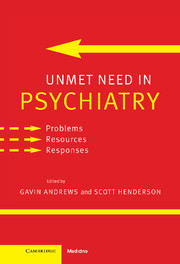Book contents
- Frontmatter
- Contents
- List of Contributors
- Preface
- Part I Unmet need: defining the problem
- Part II Unmet need: general problems and solutions
- Introduction
- 4 The epidemiology of mental disorder treatment need: community estimates of ‘medical necessity’
- 5 Some considerations in making resource allocation decisions for the treatment of psychiatric disorders
- 6 The need for psychiatric treatment in the general population
- 7 Comparing data on mental health service use between countries
- 8 The challenges of meeting the unmet need for treatment: economic perspectives
- 9 Unmet need for prevention
- 10 Meeting unmet needs: can evidence-based approaches help?
- 11 Unmet need for management of mental disorders in primary care
- 12 Is complementary medicine filling needs that could be met by orthodox medicine?
- Part III Unmet need: people with specific disorders
- Part IV Unmet need: specific issues
- Part V Unmet need: conclusion
- Index
9 - Unmet need for prevention
from Part II - Unmet need: general problems and solutions
Published online by Cambridge University Press: 21 August 2009
- Frontmatter
- Contents
- List of Contributors
- Preface
- Part I Unmet need: defining the problem
- Part II Unmet need: general problems and solutions
- Introduction
- 4 The epidemiology of mental disorder treatment need: community estimates of ‘medical necessity’
- 5 Some considerations in making resource allocation decisions for the treatment of psychiatric disorders
- 6 The need for psychiatric treatment in the general population
- 7 Comparing data on mental health service use between countries
- 8 The challenges of meeting the unmet need for treatment: economic perspectives
- 9 Unmet need for prevention
- 10 Meeting unmet needs: can evidence-based approaches help?
- 11 Unmet need for management of mental disorders in primary care
- 12 Is complementary medicine filling needs that could be met by orthodox medicine?
- Part III Unmet need: people with specific disorders
- Part IV Unmet need: specific issues
- Part V Unmet need: conclusion
- Index
Summary
Preventive as compared to treatment interventions should be considered in terms of the evidence of their effectiveness in achieving relevant outcomes. Barriers to a preventive approach are examined. Two main types of syndrome are thought to be suitable for preventive approaches. The first are the externalizing, aggressive, conduct, antisocial behavioral syndromes, while the second are the internalizing, withdrawing, depressive/anxiety syndromes. These syndromal patterns tend to continue throughout childhood, adolescence and into adult life, although there is overlap and comorbidity in many instances. Generic and specific risk and protective factors are examined as a background to preventive approaches.
Evidence shows that intervening with preventive measures in the prenatal, early infancy, preschool and school years reduces the severity of externalizing syndromes. Similarly, evidence shows that the severity of depressive/internalizing syndromes associated with postnatal depression and parental affective disorders can be reduced by preventive measures taken in school-based interventions, early intervention programs, and programs for children and adolescents encountering stressful life experiences. The evidence for the effectiveness of preventive as compared to treatment interventions is substantial and encompasses universal, selective and indicated interventions that have been tested in controlled trials. The potential gains from the systematic implementation of such interventions are substantial.
There is increasing recognition of the growing levels of morbidity associated with mental disorders and their major impact on public health, particularly when measured in terms of disability and the associated human and economic costs. A significant number of publications, research programs and health program initiatives demonstrate the scientific basis for prevention in the mental health field.
Keywords
- Type
- Chapter
- Information
- Unmet Need in PsychiatryProblems, Resources, Responses, pp. 132 - 145Publisher: Cambridge University PressPrint publication year: 2000
- 4
- Cited by

